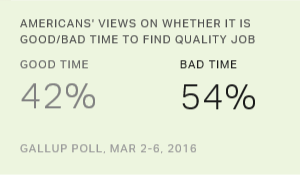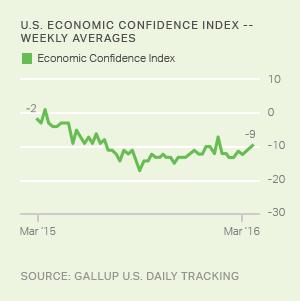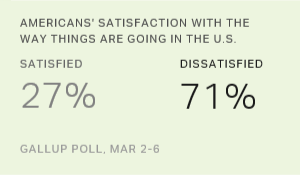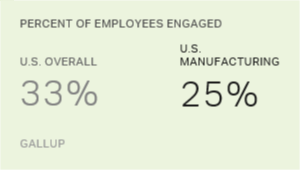Story Highlights
- 42% say it is a good time to find a quality job, 54% say it is a bad time
- Quality job optimism on par with levels seen so far in 2016
- Democrats remain more upbeat than Republicans about job market
WASHINGTON, D.C. -- Americans' perceptions of the U.S. job market remain moderately optimistic. Forty-two percent of Americans say now is a "good time" to find a quality job, similar to most readings over the past two years, but slightly below the 45% found most recently in January 2016 and September 2015. This figure is well above the levels seen during the 2007-2009 recession and in the years that followed, when the percentage who said it was a good time to find a quality job sank into the single digits.

Gallup has asked Americans to evaluate the availability of good jobs in the U.S. each month since August 2001. In early 2007, 48% said it was a good time to find a quality job, the highest percentage Gallup has recorded for this question. However, optimism about the job market fell rapidly amid the economic recession and bottomed out at 8% in late 2009. From then until 2013, fewer than one in five Americans said it was a good time to find a quality job.
Confidence about the job market subsequently improved until early 2015, when 45% of Americans said it was a good time to find a quality job, close to the record high recorded in 2007. Since then, readings on this measure have been relatively stable, with between 38% and 45% of Americans saying it is a good time to find a quality job.
Democrats Remain More Upbeat Than Republicans About Job Market
Americans who identify as Democrats or who lean Democratic (54%) are much more likely than Republicans and those who lean Republican to say it is a good time to find a quality job (28%), a pattern that has been found since early 2012. Gallup has found that party identification is closely linked to views on the availability of quality jobs, with Americans who identify with the party of the president generally feeling more upbeat than those who identify with the other party. There was an exception between 2009 and 2012, however, when both Democrats and Republicans were fairly negative about the availability of quality jobs in the U.S.
| Good time% | |||||||||||||||||||||||||||||||||||||||||||||||||||||||||||||||||||||||||||||||||||||||||||||||||||
|---|---|---|---|---|---|---|---|---|---|---|---|---|---|---|---|---|---|---|---|---|---|---|---|---|---|---|---|---|---|---|---|---|---|---|---|---|---|---|---|---|---|---|---|---|---|---|---|---|---|---|---|---|---|---|---|---|---|---|---|---|---|---|---|---|---|---|---|---|---|---|---|---|---|---|---|---|---|---|---|---|---|---|---|---|---|---|---|---|---|---|---|---|---|---|---|---|---|---|---|
| Republicans/Leaners | 28 | ||||||||||||||||||||||||||||||||||||||||||||||||||||||||||||||||||||||||||||||||||||||||||||||||||
| Democrats/Leaners | 54 | ||||||||||||||||||||||||||||||||||||||||||||||||||||||||||||||||||||||||||||||||||||||||||||||||||
| Men | 45 | ||||||||||||||||||||||||||||||||||||||||||||||||||||||||||||||||||||||||||||||||||||||||||||||||||
| Women | 39 | ||||||||||||||||||||||||||||||||||||||||||||||||||||||||||||||||||||||||||||||||||||||||||||||||||
| White | 37 | ||||||||||||||||||||||||||||||||||||||||||||||||||||||||||||||||||||||||||||||||||||||||||||||||||
| Nonwhite | 54 | ||||||||||||||||||||||||||||||||||||||||||||||||||||||||||||||||||||||||||||||||||||||||||||||||||
| 18 to 29 | 55 | ||||||||||||||||||||||||||||||||||||||||||||||||||||||||||||||||||||||||||||||||||||||||||||||||||
| 30 to 49 | 45 | ||||||||||||||||||||||||||||||||||||||||||||||||||||||||||||||||||||||||||||||||||||||||||||||||||
| 50 to 64 | 35 | ||||||||||||||||||||||||||||||||||||||||||||||||||||||||||||||||||||||||||||||||||||||||||||||||||
| 65+ | 31 | ||||||||||||||||||||||||||||||||||||||||||||||||||||||||||||||||||||||||||||||||||||||||||||||||||
| Employed | 50 | ||||||||||||||||||||||||||||||||||||||||||||||||||||||||||||||||||||||||||||||||||||||||||||||||||
| Not employed | 32 | ||||||||||||||||||||||||||||||||||||||||||||||||||||||||||||||||||||||||||||||||||||||||||||||||||
| March 2-6, 2016 | |||||||||||||||||||||||||||||||||||||||||||||||||||||||||||||||||||||||||||||||||||||||||||||||||||
| March Environment Poll | |||||||||||||||||||||||||||||||||||||||||||||||||||||||||||||||||||||||||||||||||||||||||||||||||||
Younger Americans are more optimistic than older Americans about the availability of quality jobs, as has been the case since 2009. Men are also more upbeat than women, and employed Americans are more likely to say it is a good time to find a quality job than those who are not working. Similar patterns were found in 2015 and 2014.
Bottom Line
Americans' relatively optimistic assessment of the availability of quality jobs in the U.S. appears to be correlated with other measures of hiring. Gallup's Job Creation Index, based on employed Americans' reports of hiring at their workplaces, was stable in February and remains higher than it was in the years after the recession. And as Americans' optimism about the job market improved, the unemployed rate, as measured by the Bureau of Labor Statistics, dropped from 8% as recently as 2012 to below 5% in 2016. But unemployment can decline if large numbers of people drop out of the active job market, as opposed to more people finding quality jobs.
Overall, while Americans' perceptions of the job market are certainly improved from the depths of the recession years, the current reading still means that more than half of Americans don't think it is a good time to find a quality job. While Gallup began tracking this measure in 2001, other research organizations asked the question in the late 1990s and 2000, during the dot-com boom, and found readings well above majority levels, suggesting that there is significant room for further improvement.
Historical data are available in Gallup Analytics.
Survey Methods
Results for this Gallup poll are based on telephone interviews conducted March 2-6, 2016, with a random sample of 1,019 adults, aged 18 and older, living in all 50 U.S. states and the District of Columbia. For results based on the total sample of national adults, the margin of sampling error is ±4 percentage points at the 95% confidence level. All reported margins of sampling error include computed design effects for weighting.
Each sample of national adults includes a minimum quota of 60% cellphone respondents and 40% landline respondents, with additional minimum quotas by time zone within region. Landline and cellular telephone numbers are selected using random-digit-dial methods.
View complete question responses and trends.
Learn more about how the Gallup Poll Social Series works.




